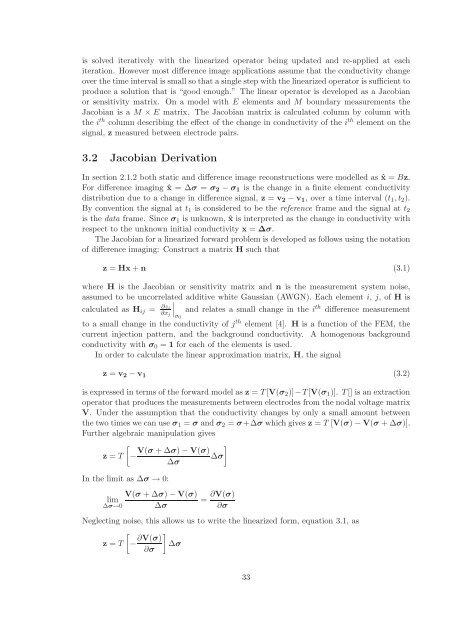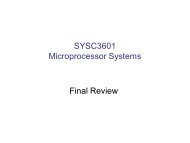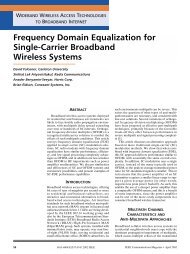Image Reconstruction for 3D Lung Imaging - Department of Systems ...
Image Reconstruction for 3D Lung Imaging - Department of Systems ...
Image Reconstruction for 3D Lung Imaging - Department of Systems ...
Create successful ePaper yourself
Turn your PDF publications into a flip-book with our unique Google optimized e-Paper software.
is solved iteratively with the linearized operator being updated and re-applied at each<br />
iteration. However most difference image applications assume that the conductivity change<br />
over the time interval is small so that a single step with the linearized operator is sufficient to<br />
produce a solution that is “good enough.” The linear operator is developed as a Jacobian<br />
or sensitivity matrix. On a model with E elements and M boundary measurements the<br />
Jacobian is a M × E matrix. The Jacobian matrix is calculated column by column with<br />
the i th column describing the effect <strong>of</strong> the change in conductivity <strong>of</strong> the i th element on the<br />
signal, z measured between electrode pairs.<br />
3.2 Jacobian Derivation<br />
In section 2.1.2 both static and difference image reconstructions were modelled as ˆx = Bz.<br />
For difference imaging ˆx = ∆σ = σ2 − σ1 is the change in a finite element conductivity<br />
distribution due to a change in difference signal, z = v2 − v1, over a time interval (t1,t2).<br />
By convention the signal at t1 is considered to be the reference frame and the signal at t2<br />
is the data frame. Since σ1 is unknown, ˆx is interpreted as the change in conductivity with<br />
respect to the unknown initial conductivity x = ∆σ.<br />
The Jacobian <strong>for</strong> a linearized <strong>for</strong>ward problem is developed as follows using the notation<br />
<strong>of</strong> difference imaging: Construct a matrix H such that<br />
z = Hx + n (3.1)<br />
where H is the Jacobian or sensitivity matrix and n is the measurement system noise,<br />
assumed to be uncorrelated additive white Gaussian (AWGN). Each element i, j, <strong>of</strong> H is<br />
calculated as Hij = ∂zi<br />
�<br />
�<br />
and relates a small change in the ith difference measurement<br />
� ∂xj σ0<br />
to a small change in the conductivity <strong>of</strong> jth element [4]. H is a function <strong>of</strong> the FEM, the<br />
current injection pattern, and the background conductivity. A homogenous background<br />
conductivity with σ0 = 1 <strong>for</strong> each <strong>of</strong> the elements is used.<br />
In order to calculate the linear approximation matrix, H, the signal<br />
z = v2 − v1<br />
(3.2)<br />
is expressed in terms <strong>of</strong> the <strong>for</strong>ward model as z = T[V(σ2)]−T[V(σ1)]. T[] is an extraction<br />
operator that produces the measurements between electrodes from the nodal voltage matrix<br />
V. Under the assumption that the conductivity changes by only a small amount between<br />
the two times we can use σ1 = σ and σ2 = σ+∆σ which gives z = T [V(σ) − V(σ + ∆σ)].<br />
Further algebraic manipulation gives<br />
�<br />
�<br />
V(σ + ∆σ) − V(σ)<br />
z = T − ∆σ<br />
∆σ<br />
In the limit as ∆σ → 0:<br />
V(σ + ∆σ) − V(σ)<br />
lim<br />
∆σ→0 ∆σ<br />
= ∂V(σ)<br />
∂σ<br />
Neglecting noise, this allows us to write the linearized <strong>for</strong>m, equation 3.1, as<br />
�<br />
z = T − ∂V(σ)<br />
�<br />
∆σ<br />
∂σ<br />
33





